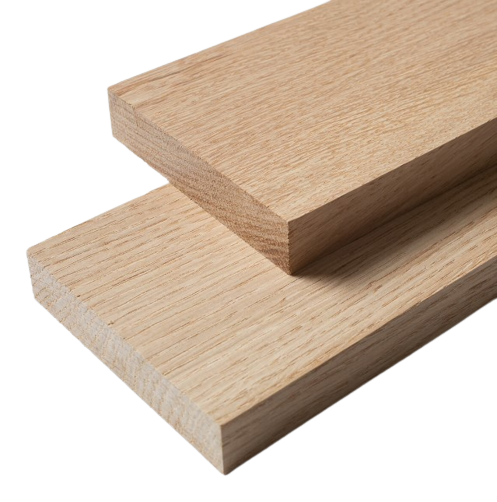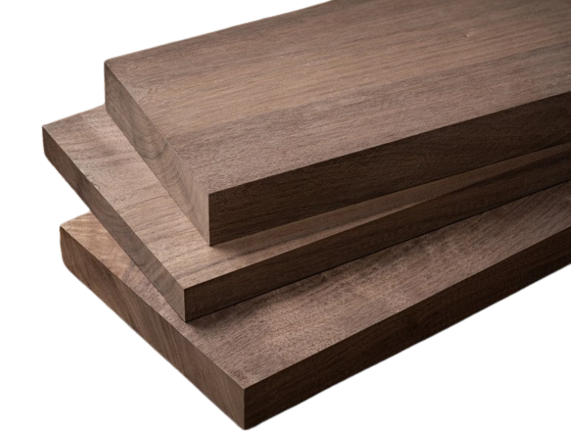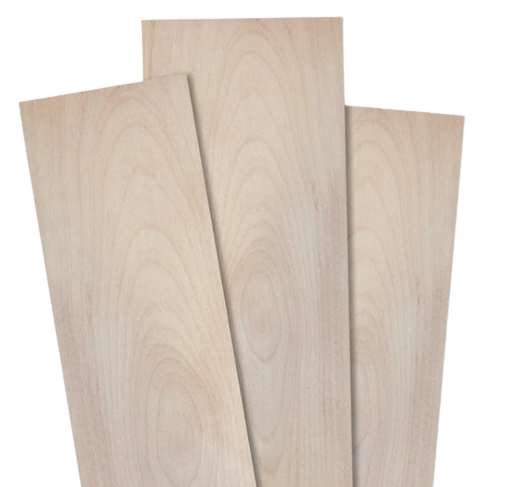Hardwood is like nature’s treasure chest of strong and beautiful woods used for building amazing things. From the toughness of oak to the fancy mahogany, each type has its special charm and use. In this immersive exploration, we will uncover the distinct personalities of hardwoods—each with its unique color palette, grain patterns, and applications. Whether you are a seasoned artisan or a budding wood enthusiast, this guide invites you to discover the richness and diversity that different types of hardwood bring to the world of woodworking.
Exploring Types of Hardwood & Their Distinctive Characteristics
1. Oak

Oak, a popular hardwood variety renowned for its robustness and resilience, is often called the king of hardwoods. It boasts a medium to coarse texture with a beautiful grain pattern that enhances its aesthetic appeal. Oak is available in two primary variations: red oak and white oak.
Red oak, with its pinkish hue, is known for its open-grain structure. It’s a durable wood, making it ideal for flooring, cabinetry, and furniture. The grain pattern of red oak adds character to any piece, and it takes well to staining, allowing for a range of finish options.
White oak, on the other hand, has a more subtle grain pattern, known for its closed-grain structure. Its resistance to moisture makes it an excellent choice for outdoor furniture, boat building, and even wine barrels. White oak’s light to medium brown color with a grayish cast lends it a timeless and versatile quality.
2. Maple

Maple appreciated for its light color and fine texture, is a hardwood species that brings a sense of elegance to any project. It’s characterized by its pale and uniform appearance, making it an excellent choice for a clean, modern look.
Maple is generally divided into two types: hard maple and soft maple.
Hard maple, with its distinct grain pattern and pale, creamy color, is incredibly durable. It’s often used for flooring, kitchen cabinets, and butcher blocks. Its dense nature allows it to take well to staining, creating a beautiful, polished finish.
Soft maple, despite the name, is still considered a hardwood. It features a more subdued grain pattern and a slightly lighter hue than hard maple. Soft maple is a versatile wood used for furniture, millwork, and decorative items. Its workability and fine texture make it a preferred choice for intricate designs.
3. Cherry

Cherry wood exudes warmth and charm with its reddish-brown color and fine grain. As it ages, cherry darkens and takes on a deep, rich patina. This unique aging process sets Cherry apart from other hardwoods.
Cherry wood often earns selection due to its sheer beauty, positioning it ideally for crafting high-end furniture, designing cabinetry, and enhancing decorative elements. Exposed to natural light, the wood’s rich, reddish hue becomes accentuated, adding a touch of elegance to any interior and fostering a welcoming atmosphere with its warm tones.
4. Walnut

Walnut, exuding sophistication with its chocolate-brown to purplish-black hue, is a hardwood renowned for its deep, rich color and fine, straight grain. Craftsmen often consider walnuts a luxurious choice for their woodworking projects due to these exceptional qualities.
The dark, distinctive appearance of walnut makes it a favorite for crafting fine furniture, cabinets, and gunstocks. Its workability and elegant look have made it a staple in high-end interior designs. While walnut can be more expensive than other hardwoods, its timeless beauty is well worth the investment.
5. Mahogany

Mahogany wood is synonymous with luxury. Its reddish-brown color, often deepening to a stunning red or dark brown, adds a touch of opulence to any project. Mahogany is divided into several types, with African mahogany and genuine mahogany (Honduran or big-leaf mahogany) being the most notable.
African mahogany offers a similar appearance to genuine mahogany but at a more affordable price. It’s often used in furniture making, boat building, and interior trim work. Its color deepens over time, giving your project a rich and regal look.
Genuine mahogany, on the other hand, is the crème de la crème of hardwoods. Its reddish-brown color and fine, straight grain have made it a top choice for fine furniture, high-end cabinetry, and musical instruments. The sheer elegance of genuine mahogany is hard to match.
6. Ash

Ash, recognized for its pronounced grain pattern and its cream-colored to light-brown appearance, stands as a robust choice for tool handles, sports equipment, furniture, and flooring. Its strength and shock resistance make it a preferred choice for various applications.
7. Hickory

Hickory, distinguished by its pale to reddish-brown color, stands out for its extraordinary hardness and exceptional strength. This hardwood finds extensive application in crafting tool handles, constructing ladder rungs, installing flooring, and designing cabinetry, primarily owing to its remarkable durability and robust load-bearing capabilities.
8. Birch

Renowned for its affordability and ease of finishing, birch presents a pale yellow to light reddish-brown color with an even texture. This makes it a versatile choice for various projects, including plywood, veneer, high-end cabinetry, and furniture. Birch is often preferred for these applications, ensuring a cost-effective and user-friendly option for craftsmen and builders.
9. Teak

Teak wood earns its reverence due to its captivating golden to medium brown color and the natural oils it possesses, granting it exceptional resistance to various weather conditions. Craftsmen frequently opt for teak when designing outdoor furniture, engaging in boat construction, and creating fine cabinetry. Its enduring durability and innate beauty make it a preferred choice for these applications.
10. Sapele

Sapele wood boasts a dark reddish-brown to purplish-brown color with an interlocked grain. Its stunning appearance & workability make it a favorite for furniture, cabinetry, musical instruments, and boat building. Transitioning between these hardwood varieties allows you to expand your woodworking repertoire, offering depth and variety to your projects. Explore the world of hardwoods, where each type tells its unique story and plays a vital role in the creation of something truly exceptional.
How to Choose the Best Type of Hardwood for Your Project?
Selecting the ideal hardwood for your project is a crucial step, begin by considering the specific attributes of different types of hardwood. For instance, you might opt for oak, known for its durability and beautiful grain patterns, if you’re working on flooring or cabinetry.
Maple on the other hand with its fine texture and uniform appearance, is an excellent choice for a clean and modern look, making it suitable for a variety of applications.
By exploring the characteristics of the most common types of hardwood empowers you to make informed decisions, guaranteeing the success of your project. Delving into the details of these sought-after hardwood varieties and understanding their unique properties provides valuable insights for crafting with confidence.
In conclusion, the world of hardwood offers diverse options, each with its unique story and characteristics. Whether you’re seeking the warmth of cherry, the elegance of maple, or the luxury of mahogany, these hardwood types offer a palette of possibilities for craftsmen & builders. Transitioning from one hardwood to another can bring out the best in your projects, adding depth and variety to your woodworking repertoire.
For a deeper exploration and a wealth of hardwood information, make Timber Explore your trusted companion. With its invaluable resources, it empowers you to make well-informed choices, guiding you on your woodworking journey toward excellence.

